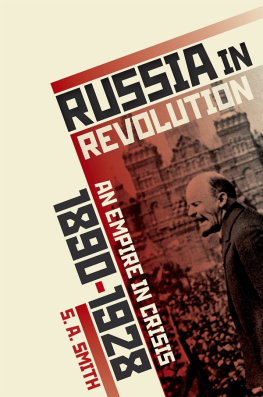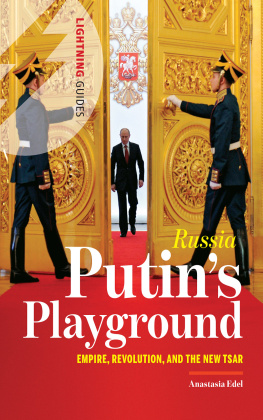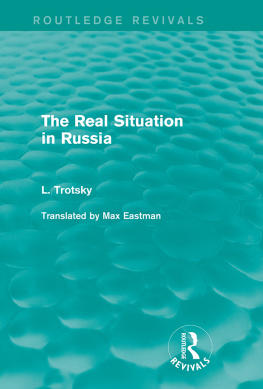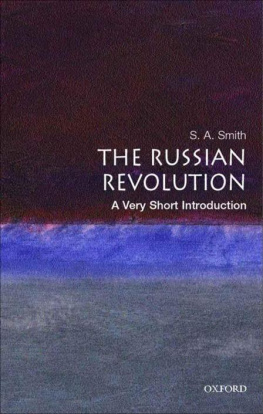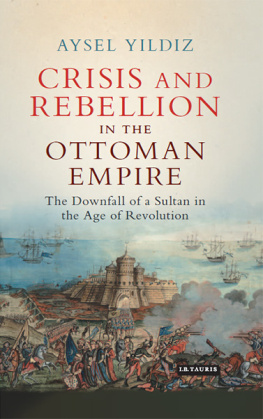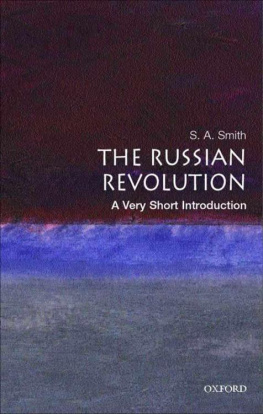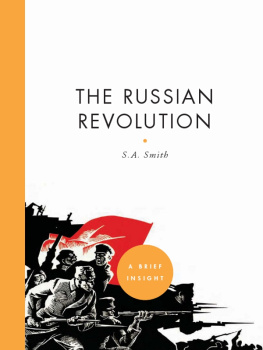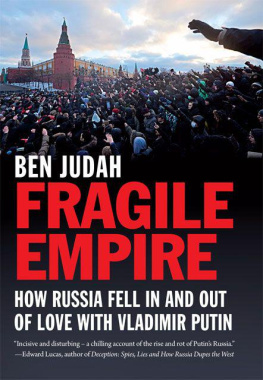S.A. Smith - Russia in Revolution: An Empire in Crisis, 1890 to 1928
Here you can read online S.A. Smith - Russia in Revolution: An Empire in Crisis, 1890 to 1928 full text of the book (entire story) in english for free. Download pdf and epub, get meaning, cover and reviews about this ebook. City: Oxford, year: 2017, publisher: Oxford University Press, genre: History. Description of the work, (preface) as well as reviews are available. Best literature library LitArk.com created for fans of good reading and offers a wide selection of genres:
Romance novel
Science fiction
Adventure
Detective
Science
History
Home and family
Prose
Art
Politics
Computer
Non-fiction
Religion
Business
Children
Humor
Choose a favorite category and find really read worthwhile books. Enjoy immersion in the world of imagination, feel the emotions of the characters or learn something new for yourself, make an fascinating discovery.
Russia in Revolution: An Empire in Crisis, 1890 to 1928: summary, description and annotation
We offer to read an annotation, description, summary or preface (depends on what the author of the book "Russia in Revolution: An Empire in Crisis, 1890 to 1928" wrote himself). If you haven't found the necessary information about the book — write in the comments, we will try to find it.
S.A. Smith: author's other books
Who wrote Russia in Revolution: An Empire in Crisis, 1890 to 1928? Find out the surname, the name of the author of the book and a list of all author's works by series.
Russia in Revolution: An Empire in Crisis, 1890 to 1928 — read online for free the complete book (whole text) full work
Below is the text of the book, divided by pages. System saving the place of the last page read, allows you to conveniently read the book "Russia in Revolution: An Empire in Crisis, 1890 to 1928" online for free, without having to search again every time where you left off. Put a bookmark, and you can go to the page where you finished reading at any time.
Font size:
Interval:
Bookmark:

Great Clarendon Street, Oxford, ox 2 6 dp , United Kingdom
Oxford University Press is a department of the University of Oxford. It furthers the Universitys objective of excellence in research, scholarship, and education by publishing worldwide. Oxford is a registered trade mark of Oxford University Press in the UK and in certain other countries
S. A. Smith 2017
The moral rights of the author have been asserted
First Edition published in 2017
Impression: 1
All rights reserved. No part of this publication may be reproduced, stored in a retrieval system, or transmitted, in any form or by any means, without the prior permission in writing of Oxford University Press, or as expressly permitted by law, by licence or under terms agreed with the appropriate reprographics rights organization. Enquiries concerning reproduction outside the scope of the above should be sent to the Rights Department, Oxford University Press, at the address above
You must not circulate this work in any other form and you must impose this same condition on any acquirer
Published in the United States of America by Oxford University Press 198 Madison Avenue, New York, NY 10016, United States of America
British Library Cataloguing in Publication Data
Data available
Library of Congress Control Number: 2016943367
ISBN 9780198734826
ebook ISBN 9780191054044
Printed in Great Britain by Clays Ltd, St Ives plc
Links to third party websites are provided by Oxford in good faith and for information only. Oxford disclaims any responsibility for the materials contained in any third party website referenced in this work.
The book has been much improved as a result of detailed comments by Nicholas Stargardt and Chris Ward, both of whom read the whole manuscript, and by David Priestland and Ian Thatcher who read crucial sections. I also benefited from conversation with Erik Landis. I thank all of them warmly. None bears any responsibility for any errors that remain. I would like to thank the Warden and Fellows of All Souls College, Oxford, for the senior research fellowship that allowed me to write the book.
As ever, the book is dedicated to Phil Jakes.
S.A.S.
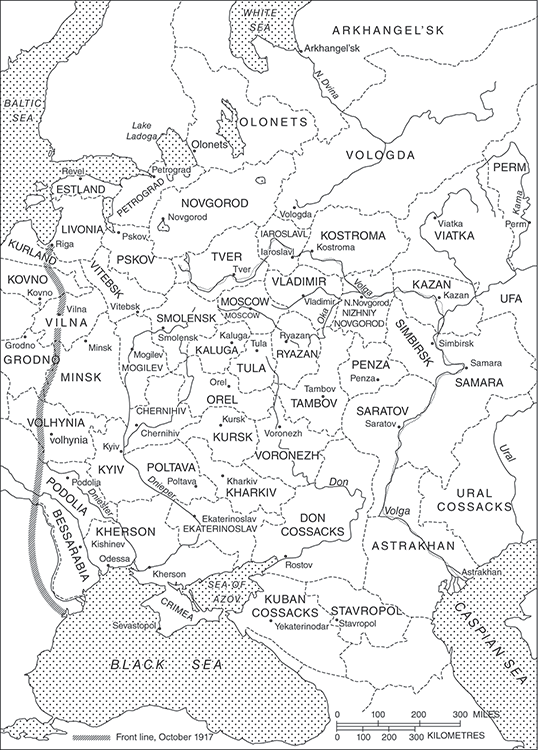
Map 1 European Russia in 191718
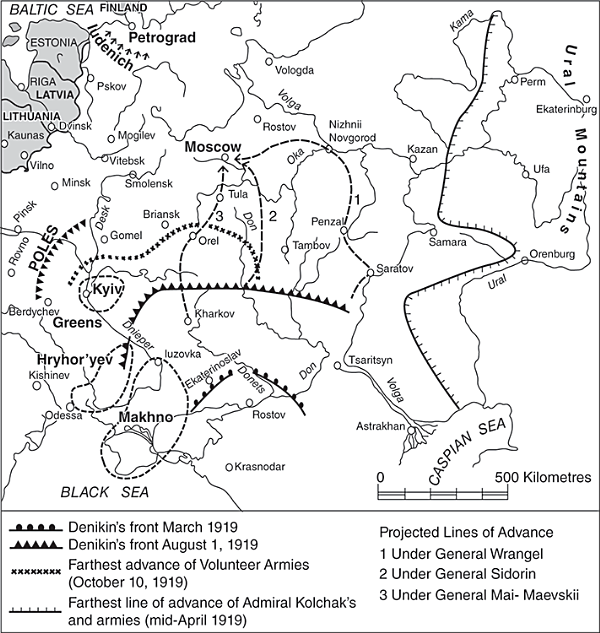
Map 2 The White Armies in 1919
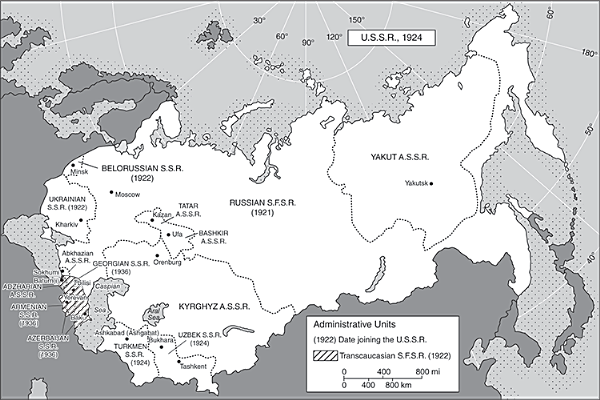
Map 3 The Soviet Union in 1924
The Revolution was a grand thing! continued Monsieur Pierre, betraying by this desperate and provocative proposition his extreme youth.
What? Revolution and regicide a grand thing?
I am not speaking of regicide, I am speaking about ideas.
Yes: ideas of robbery, murder, and regicide, again interjected an ironical voice.
Those were extremes, no doubt, but they are not what is most important. What is important are the rights of man, emancipation from prejudices, and equality of citizenship.
Tolstoy, War and Peace
As Tolstoy wonderfully captures in the opening scene of his masterpiece War and Peace, the historical significance of the French Revolution was bitterly contested throughout the nineteenth century and indeed for most of the twentieth. In 1978 to power. I have sought to avoid moralizing and to write with sympathy about those to whom I feel some aversion and, conversely, to write critically of those to whom I am more positively disposed. But for the reader who would like to pin a label on me at the outsetand a reader certainly has the right to know where an author standsI suggest they start with the conclusion.
This book is written primarily for the reader coming new to the subject, although I hope that, as a synthesis of recent research by Russian and western scholars, and as an attempt to question some familiar interpretations, it will have something of interest to say to my academic colleagues. The book offers a comprehensive account of the main events, developments, and personalities in the former Russian empire from the late nineteenth century through to the onset of the First Five-Year Plan and forced collectivization in 1928/9, when Stalin unleashed a revolution from above on the Soviet people. It seeks to answer the big questions that interest school students, undergraduates, and the general reader who enjoys learning about the past. Why did the tsarist autocracy fail? Why did the attempt to establish parliamentary democracy after the February Revolution of 1917 also fail? How did a small extreme socialist party manage to seize power and to sustain itself through a ferocious civil war (191821)? How did Stalin rise to power? Why did he unleash brutal collectivization and crash industrialization on the Soviet people at the end of the 1920s? At the most fundamental level the book aims to offer some insight into the nature of power: how the determination to continue to rule in the old way can lead to the collapse of an entire social order or how those seeking to create a better society become corrupted by their determination to hold on to power at any price. These are all hoary issues, but since the fall of the Soviet Union in 1991 a mass of new source-material has become available that sheds much fresh light on the political and social history of this period. Over the past quarter of a century historians in Russia and the West have begun to use this material to reexamine old questions, to raise new ones, and to rethink some entrenched categories. The book seeks to reflect this archivally based scholarship and to give the general reader a sense of how scholarly understanding of the Russian Revolution has changed over recent decades. At the same time, it reflects the fact that the Russian Revolution continues to be a subject on which historians interpretations differ greatly. Its main purpose, however, is to offer the general reader a wide-ranging account of the collapse of the tsarist autocracy and the rise of a Bolshevik party, but one that pays more attention than was possible prior to 1991 to such matters as the imperial and national dimensions of the Revolution, to the complexity of forces involved in the civil war, to the attempts by moderate socialist and anarchist parties to resist the Bolshevik monopolization of power, to peasant and worker resistance to the Bolshevik regime, to the massive economic privation and suffering wrought by the Revolution, to the conflict between Church and state, and to the economic and social contradictions of the Soviet Union under the New Economic Policy of the 1920s.
Revolutions are about the breakdown of states, the competition between rival contenders for power, and the ultimate reconstitution of a new state power. For that reason, the backbone of the narrative is political, and it ranges back to the time of the Great Reforms of Alexander II in the 1860s and forward into the high Stalinism of the 1930s. The choice of a longish time-frame is motivated by the fact that the book seeks to emphasize some important continuities across the revolutionary divide of 1917. Fundamentally, developments are analysed in terms of the interplay between external pressures (geopolitics and rivalry within the international state system) and internal pressures that derived from the undermining of social hierarchies by rapid economic modernization. Revolutions are not created by revolutionaries, who at most help to erode the legitimacy of the existing regime by suggesting that a better world is possible. So less attention is devoted to the political activities and arguments of revolutionaries prior to 1917 than in some standard histories. As Lenin himself well knew, it is only when the existing order is in deep crisis that revolutionaries can break out of political isolation and seek to mobilize popular forces to bring the old order to its knees. For virtually all the socialist revolutions of the twentieth century, it was not a crisis of the capitalist system, but imperialist war that pushed old orders into crisis, so war figures large in my account.
Font size:
Interval:
Bookmark:
Similar books «Russia in Revolution: An Empire in Crisis, 1890 to 1928»
Look at similar books to Russia in Revolution: An Empire in Crisis, 1890 to 1928. We have selected literature similar in name and meaning in the hope of providing readers with more options to find new, interesting, not yet read works.
Discussion, reviews of the book Russia in Revolution: An Empire in Crisis, 1890 to 1928 and just readers' own opinions. Leave your comments, write what you think about the work, its meaning or the main characters. Specify what exactly you liked and what you didn't like, and why you think so.

